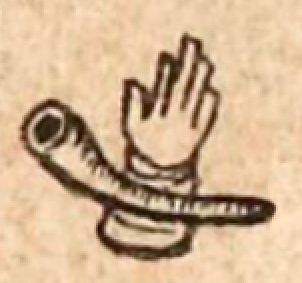Xoma (Verg21v)
This black-line drawing of the compound glyph for the personal name Xoma (“Clay Spoon,” attested here as a man’s name) shows a frontal view of a clay spoon (or clay pipe?). The spoon or pipe has shading that makes it three-dimensional. It is what appears to be a dark/black hole at the broader end of the object that makes it appear more like a pipe. Behind this item is an upright left hand.
Stephanie Wood
The hand is a phonetic indicator that the ceramic object ends with "-ma." We presume that this name is Xoma and not Xoman, as the gloss might indicate, given the root for the term for clay spoon would not have a final "n." The letter "n" is often intrusive. Some names do end in -man, however, referring to "in the manner of." Still, with "in the manner of a clay spoon," one might expect Xomaman. Regardless, Compare this object with the pipe below that shows smoke swirling up from the bowl. One wonders whether it is a spoon or a pipe that is the referent here.
Stephanie Wood
jua.xomā
Juan Xoma (or perhaps Juan Xoman)
Stephanie Wood
1539
Jeff Haskett-Wood

xoma(tli), clay spoon, https://nahuatl.wired-humanities.org/content/xomatli
ma(itl), hand, https://nahuatl.wired-humanities.org/content/maitl
-man(i), in the manner of, https://nahuatl.wired-humanities.org/content/mani-1
Cuchillo de Barro
Stephanie Wood
Codex Vergara, folio 21v, https://gallica.bnf.fr/ark:/12148/btv1b84528032/f50.item.zoom
The non-commercial reuse of images from the Bibliothèque nationale de France is free as long as the user is in compliance with the legislation in force and provides the citation: “Source gallica.bnf.fr / Bibliothèque nationale de France” or “Source gallica.bnf.fr / BnF.” We would also appreciate a citation to the Visual Lexicon of Aztec Hieroglyphs, https://aztecglyphs.wired-humanities.org/.





